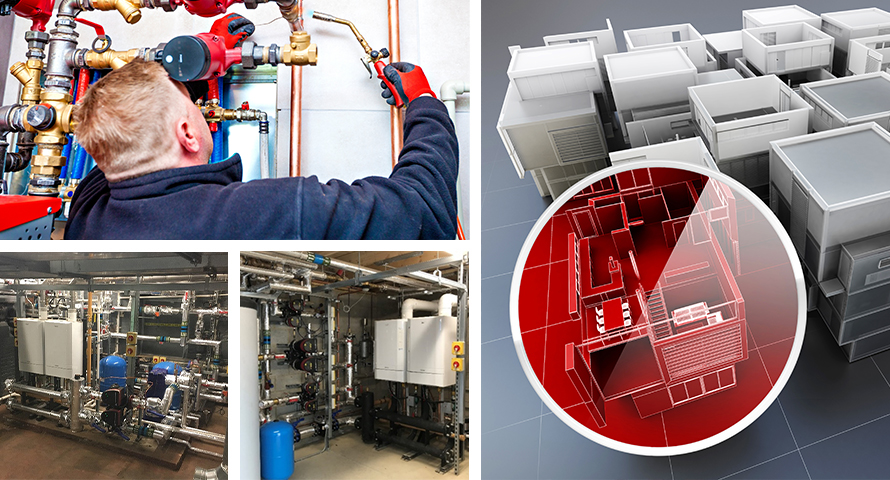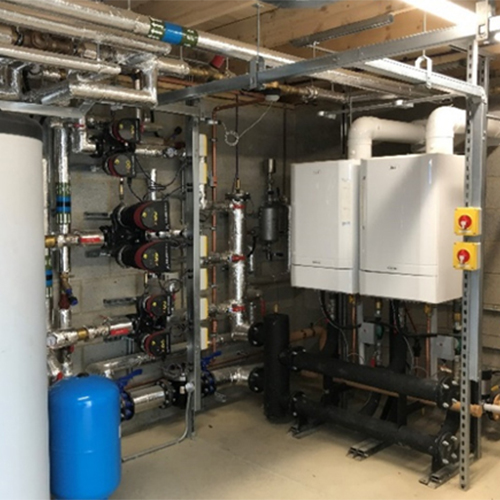- 01535 652338
- mail@watsonsbs.com

Keeping Out the Cold: How LTHW Systems Help Reduce Energy Consumption and Costs
Heating working spaces is a challenge as old as time but in an age of weather extremes and rising energy costs, it is not enough to simply generate heat. Energy efficiency and environmental impact are at the top of the list when considering heating systems that provide a quality of comfort in public and working buildings.
With sustainability at the core of our approach to building services, Watsons provides a variety of HVAC solutions that offer cost-efficient heating with a reduced environmental footprint. These solutions include:
Heat Pump Systems: Colder air from outside is passed over heat exchangers to produce heated air indoors. The amount of heat they produce is significantly higher than the electricity they consume, making them highly energy efficient.
Heat Recovery Systems: Thermal energy usually lost through entropy is extracted from the room and passed back through heat exchangers to recycle back into the room as fresh and filtered heated air. Combined with a heat pump system we can create an all-in-one solution for energy-efficient heating and cooling, such as the one supplied to a Daventry Distribution Centre in 2020
Air-Conditioned Heating Systems: By reverse cycling air conditioning units, the evaporator inside the building takes the cold out of the air and blows heat in. When combined with our multi-split systems, various spaces within the building can be heated to different levels as needed via an integrated BMS system or Central Controller.
Low-Temperature Hot Water (LTHW) systems: One of the most popular choices for heating buildings, LTHW systems are highly efficient and cost-effective. They work by heating water to a lower temperature than traditional hot water systems and distributing it via a network of pipes.
While LTHW systems might initially resemble conventional heating systems, employing boilers, pumps, and radiators, their superior efficiency lies in reduced energy consumption and their suitability for large, multi-room buildings, allowing individualised heat control. In this article, we delve into a more comprehensive exploration of LTHW.

Advantages of LTHW Systems
Combined with a range of inherent efficiencies, the cost savings and reduction in the environmental impact of LTHW Systems are significant. Below are just some of the advantages a system of this type can bring:
Efficient Heat Transfer: LTHW systems excel in efficient heat transfer due to the lower temperatures involved. This facilitates effective heat distribution through pipes, radiators, or underfloor heating systems.
Reduced Heat Loss: Lower operating temperatures in LTHW systems result in reduced heat loss during distribution, minimising energy wastage and improving overall system efficiency.
Improved Pump Efficiency: The lower viscosity of water at lower temperatures reduces pump energy requirements, enhancing the overall efficiency of the circulation system in LTHW setups.
Enhanced Component Lifecycles: Lower operating temperatures reduce the risk of corrosion and scaling in heat exchangers and reduce thermal stress on system components generally, leading to extended lifespans and a minimised risk of failure.
Zoned Control and Variable Flow Rates: LTHW systems support zoned heating control, allowing variable flow rates to different areas. This precision optimises energy usage and provides tailored heating solutions for diverse spaces.
Advanced Control Systems: LTHW systems often feature advanced control systems that optimise temperature regulation, monitor energy usage, and facilitate remote diagnostics. These systems enhance overall system management and efficiency.
Environmentally Friendly: LTHW systems seamlessly integrate with low-carbon and renewable technologies, such as heat pumps, heat recovery systems and solar thermal collectors, amplifying their sustainability and reducing reliance on conventional energy sources.
Disadvantages of LTHW Systems
Of course, when choosing the ideal heating system for your building, it's important to understand what limitations systems have. Like any technology, LTHW has potential drawbacks:
Higher Upfront Costs: Components such as radiators, heat exchangers and coils need to be slightly larger to compensate for the lower flow rates in the system, and this can mean higher component costs. However, lower flow rates also mean lower capacity pumps and pipework can be used, saving on overall costs.
Limited Compatibility: LTHW systems may not be compatible with some existing heating systems, which could mean significant modifications or even a complete replacement.
Limited Temperature Range: Although LTHW systems are ideal for the efficient heating of buildings with large spaces, multiple floors and rooms, they may not be sufficient for some applications, including many industrial processes.

LTHW Systems in Action
In 2019, Watsons were commissioned by a food manufacturer to design and install mechanical and electrical infrastructure for a new, state-of-the-art production facility, warehouse and offices. Although the new facilities were an exciting prospect for them, they had been brought about by a moment of tragedy, with a fire consuming their existing facilities.
Having a blank canvas to work with meant we could design new building systems using the latest in cost-efficient and sustainable technologies. This included a BMS-controlled LTWH system and an HVAC solution that utilises mechanical heat recovery. By implementing an efficient and environmentally friendly LTWH system, the company was able to reduce its heating costs across the facility by 20%.
Along with critical systems such as fire alarms and electrical distribution, we also designed and installed various other services that brought savings and low environmental impacts, such as 555 solar panels generating 116,000kWh per year, water conservation systems, efficient lighting, and EV charging stations.
Read the full Case Study
With optimised heat transfer, reduced heat loss, and the ability to integrate seamlessly with renewable technologies, LTHW systems showcase superior performance in various industrial and commercial settings. The precision of zoned control, quick response times, and compatibility with low-carbon solutions further solidify LTHW as an intelligent and sustainable heating solution.
Whether you have a large space, or a multi-room or multi-floor building, contact Watsons and discover how we can provide versatile, reliable, and forward-thinking technological solutions.

